Successfully implementing lean manufacturing principles (also known as the Toyota Production System or TPS) such as continuous flow production, JIT, TQM, SPC, pull production, and level production can result in impressive improvements in cycle time and production performance. Like every management system, one of the keys to success in lean manufacturing is in its implementation.
Customized Shift Work Solutions Improve Lean Systems
Shiftwork Solutions can help you improve your Lean system implementation and reduce waste:
- Match flows on the shop floor with customized shift schedules that efficiently balance labor resources between production stations.
- Respond to changing customer demands with shift schedules that have the ability to flex up and down efficiently and effectively.
- Create training opportunities for teaching lean manufacturing principles and cross-training employees.
- Make preventative maintenance part of the schedule, and match maintenance resources to the maintenance workload.
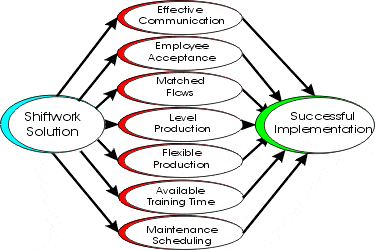
Implementing the right shift schedule can prove to be a leap forward in the continuous improvement process. In particular, a 5-day operation can significantly improve just about every aspect of Lean by simply converting to a 7-day schedule.
Some managers avoid schedules that include weekend work. This is mostly due to an anticipated adverse reaction from the workforce. The idea that a 7-day schedule is unacceptable to a workforce is outdated. Todayβs shift schedules can offer more flexibility, pay and time off while still covering all of the hours in a week.
The intent of this article is to point out how a 7-day schedule will benefit a Lean operation.
Relieve Bottlenecks
A bottleneck, or chokepoint, is the limiting factor in the speed of a process. Continuous improvement process usually deals with this phenomenon using 3-steps:
- Identify the bottleneck
- Eliminate the bottleneck
- Identify the next bottleneck
Itβs the second step in this process that represents the biggest challenge. Eliminating a bottleneck may call for capital investment. A less expensive alternative is to run the bottleneck area for more hours than the rest of the facility. Consider the chart below:

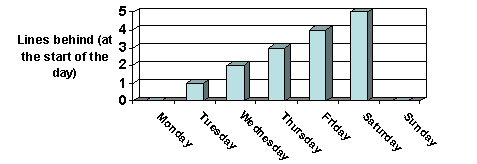
In this example, a company has seven lines that it runs for five days every week. Each of the lines is fed to a downstream process that is limited, by the bottleneck, to six lines of processing capacity per day. This means that every day the bottleneck falls behind the equivalent of one line of output for one day. By Friday night, the lines are done producing for the week. Meanwhile, the bottleneck has a backlog of five line-days worth of production. The result is:
- A stockpile of product that is not having value being added = Waste.
- Quality problems due to higher W.I.P. and slower recognition of flaws.
- Higher costs associated with higher inventory.
- Slower responsiveness to changes in orders. You cannot change what you have already produced and accumulated upstream of the bottleneck.
Now consider a similar plant with the same production requirements. However, this plant does not run all seven lines for five days. Instead, it runs five lines for seven days. In the end, both methods produce 35 line-days of work per week. Consider the following chart:

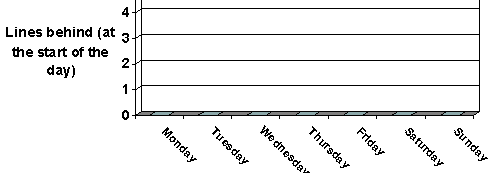
By running fewer lines for more days, the bottleneck has disappeared. What was a limiting factor now represents excess capacity. The downstream process can handle up to six lines of input a day and in this example, it only has to process five. The upstream backlog has been eliminated. W.I.P. has been reduced. Customer responsiveness has improved. Quality improves. Carrying costs are reduced.
Reduce Cycle Times
One goal of continuous improvement is to reduce cycle time, the amount of time between starting work on a unit and completing the work on that same unit. Some companies will take great efforts to reduce cycle times. Then on Friday night, they shut down the plant and turn out the lights. All of the work in process at that time will sit idle until the plant starts up again on Monday morning (56 hours later). The cycle time clock continues to tick.
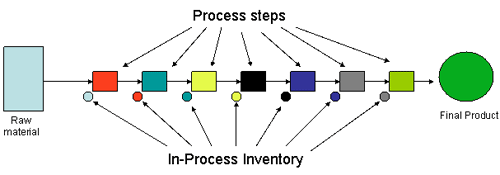
The above chart demonstrates the tremendous amount of βwait timeβ generated by simply shutting down for the weekend. Notice the production βrampsβ that proceed and follow each shutdown. A process that is well underway will typically have W.I.P. throughout (see chart below).
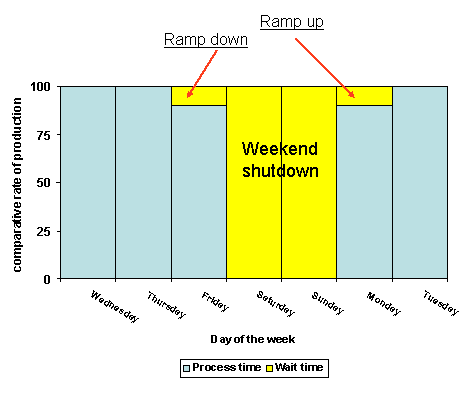
A shutdown at the end of the week may mean running all of the lines empty. This has the following impact:
- Typically, everyone goes home at the same time. This implies that workers at the start of the process become idle as their process is emptied out.
- Break downs or other, unanticipated problems can throw off a schedule designed to empty the line at a precise point in time (usually targeted for the end of a shift.)
- On Friday, the raw material is pre-staged for Monday, starting the cycle time clock just before the plant goes idle for 2 days.
- Monday’s start-up will be slow. No final product is produced until the line has completely filled back up.
Reduce W.I.P.
Most companies will avoid a 7-day schedule if they think they can reach all of the production targets with a 5-day production week. It simply does not sound right to reduce production on a daily basis so it will take seven days to meet customer demands. In reality, there are several reasons for doing this: fewer bottlenecks, improved customer responsiveness, lower inventories, and reduced W.I.P. The amount of W.I.P. is a good measure of how Lean you are actually running. Less W.I.P. means less inventory, less waiting between processes and faster responses to quality problems. The chart below shows how stretching production across seven days can reduce W.I.P.
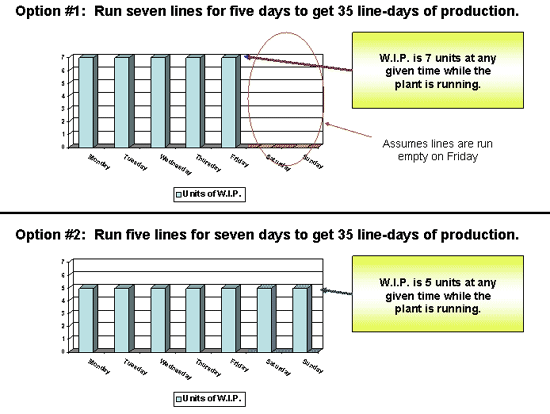
Not all operations are capable of making this change in production rate. For those that can, the result is a more than 28% reduction in W.I.P.
Reduce Warehouse Inventories
One of the signals in a pull production system comes from the final goods inventory. Once inventories drop below a certain level, more product is manufactured. In a 5-day production process, the inventory level expected for Monday morning must be achieved by the end of the workday on Friday. The result is a warehouse filled with a product that is having no value added to it. This product is being held for two days out of every seven in this condition. This is the same as saying that 28% of the time, you will be carrying a full inventory of finished product with no return on the investment.
With a 7-day production system, you will be producing over the weekend. The result is that inventories going into the weekend can be lowered. In the example below, this represents a 15% reduction in the average volume of finished goods in stock. It is worth noting that companies that produce on the weekend frequently begin to ship on the weekend as well. This will have an even greater impact on lowering inventories.
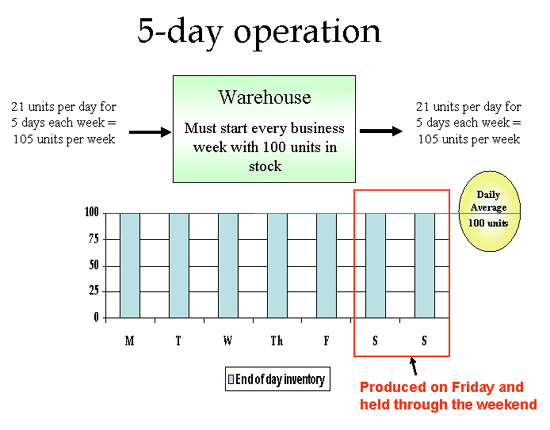
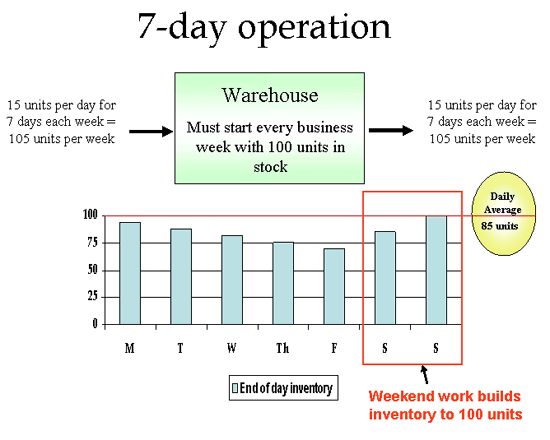
Improve Customer Responsiveness
An order comes in and is immediately scheduled for completion during the next production shift. This seems pretty responsive unless the order came in on Friday afternoon. For a 5-day operation, this translates into a 2-day wait before anyone starts to fill the order. No one is in on the weekend to do any work. With a 7-day operation, orders are received and processed without regard to the day of the week. Every day is just like the next. There is no need to schedule around a weekend. That Friday night order will be ready for shipment on Saturday.
Call Us and We Can Help
Call or text us today atΒ (415) 763-5005Β to discuss your operations and how we can help you solve your shift work problems. You can also complete ourΒ contact formΒ and we will call you.
